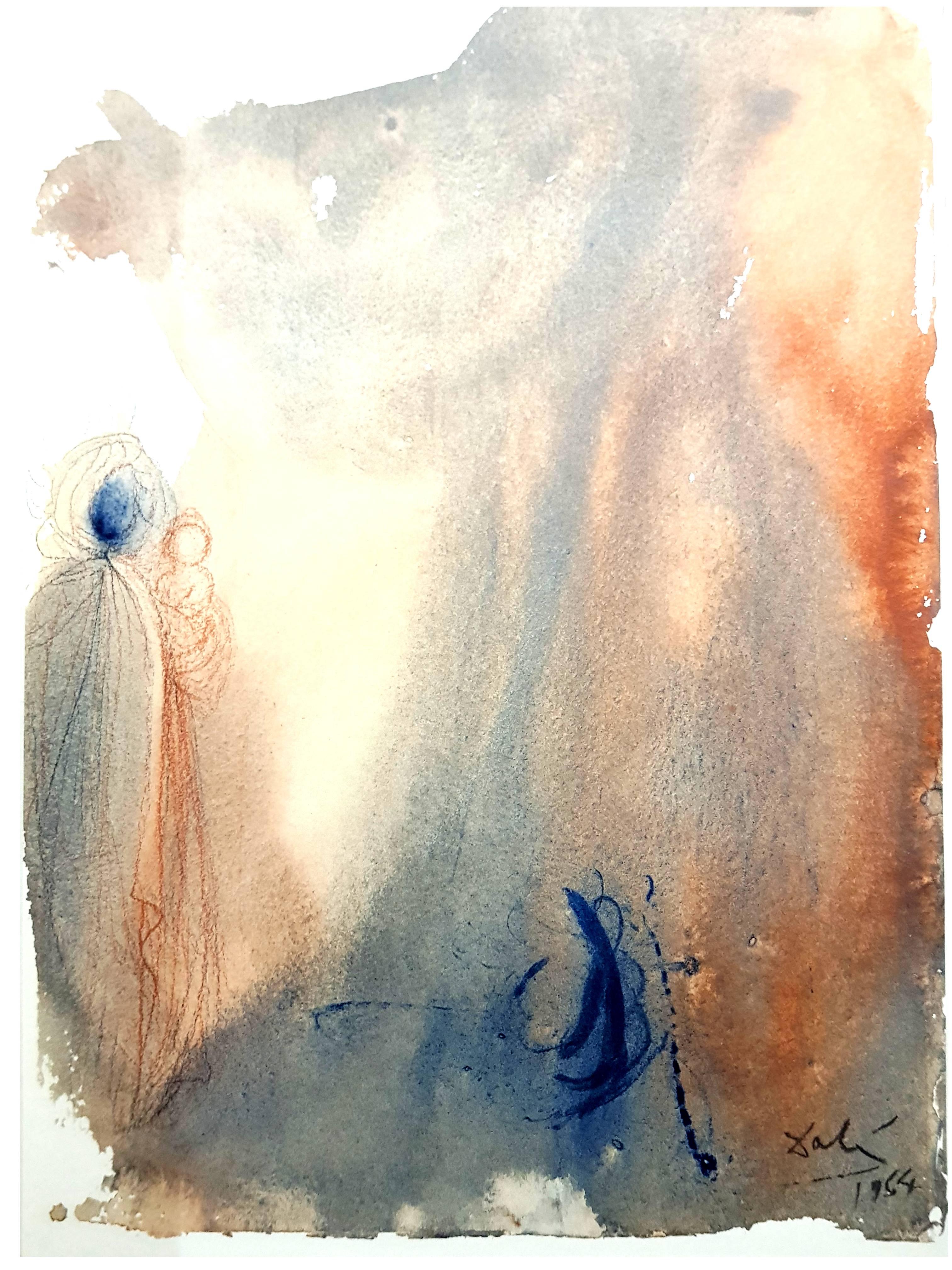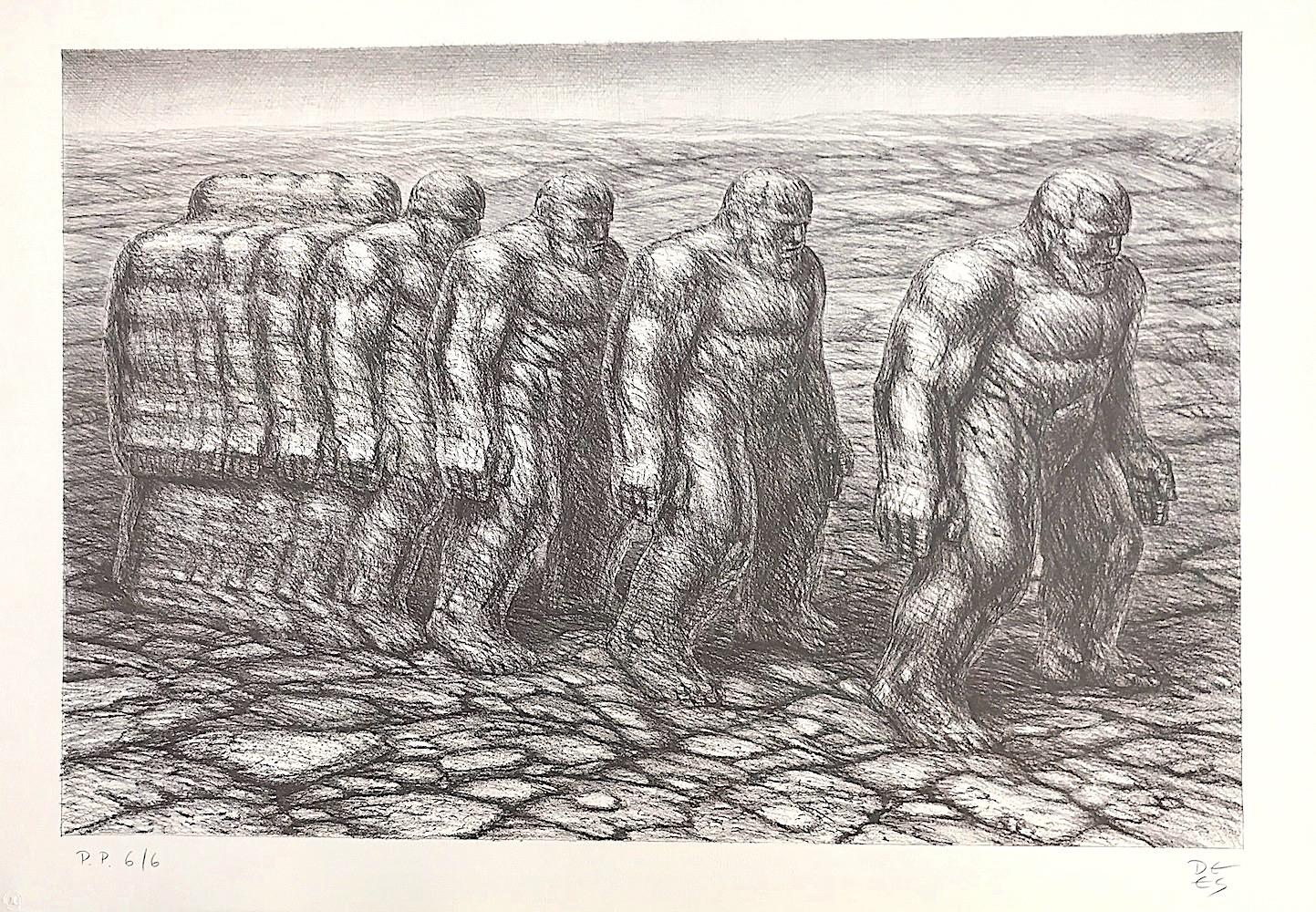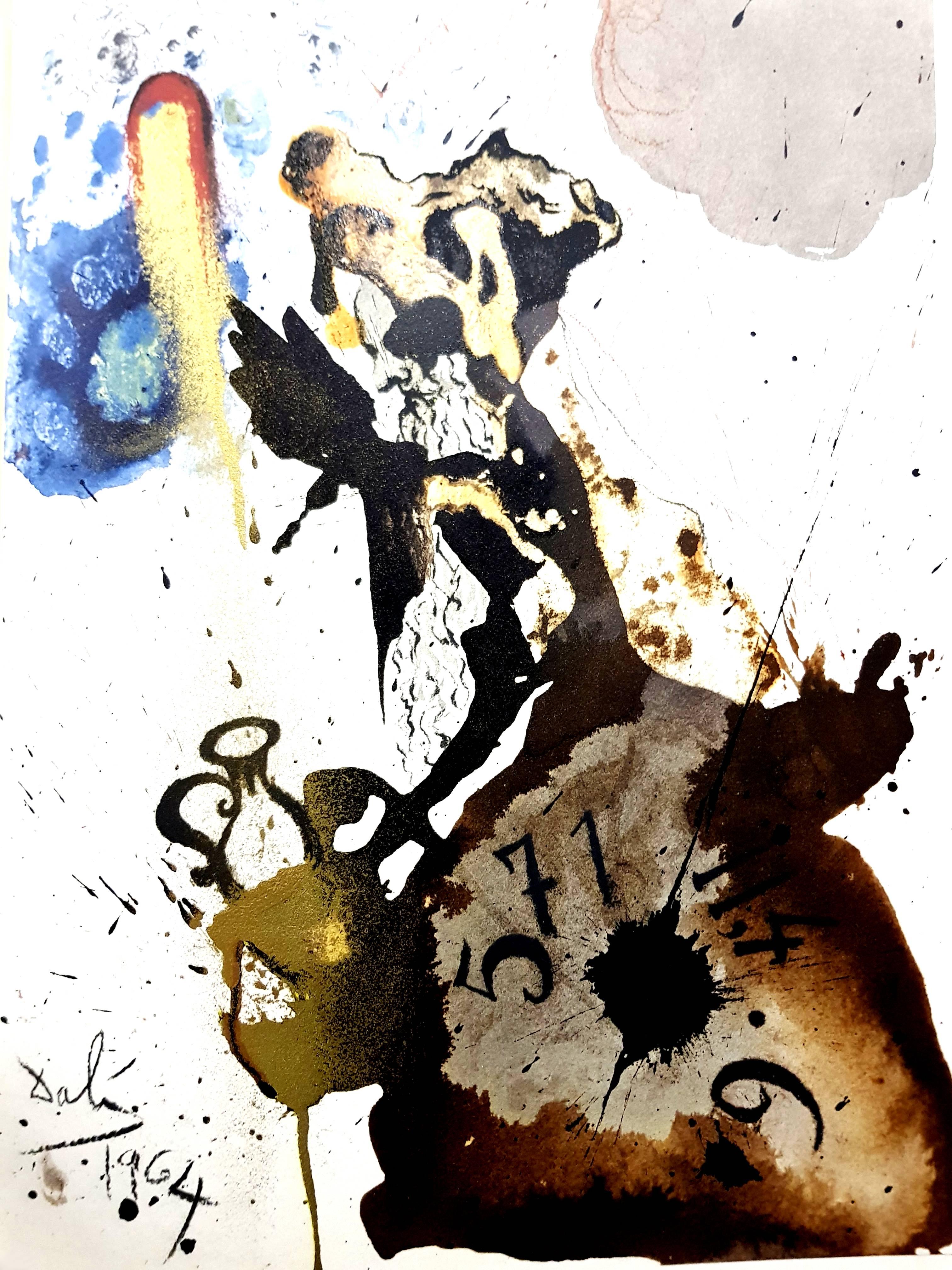Items Similar to "Vanity Fair (The Face Off) Recto, Camel Cigarette Verso, " by Paolo Garretto
Want more images or videos?
Request additional images or videos from the seller
1 of 11
Paolo Garretto"Vanity Fair (The Face Off) Recto, Camel Cigarette Verso, " by Paolo Garretto1931
1931
About the Item
This double-sided lithograph by Paolo Garretto features a Vanity Fair cover "The Face Off" on the front and a Camel Cigarette ad on the back. It was published December of 1931.
12 1/2" x 9 1/2" art
20 5/8" x 17 5/8" frame
Famous and Prolific Italian Artist who specialized in Caricatures, Cartoons and Posters who worked for magazines from the mid-1920s to late 1940s.
Paolo Garretto was a famous Italian artists of the 1930s and 1940s. Specialized in caricatures, his first work appeared in the British Caricature of Today magazine in 1928. Later on, he was attached to the Italian satirical magazine Pasquino. One of his comic creations is 'L'Automata Tabù' (1932). He was recruited by the editor of the American Vanity Fair magazine to create covers featuring prominent personalities.
Throughout the 1930s, Paolo Garretto's stylized, boldly colored political cartoons appeared on and between the covers of Vanity Fair, The New Yorker, House & Garden, and Fortune, among other publications. During World War II, Garretto was deposed to Italy and sent to a prison camp when he refused to caricature political leaders for the Nazi Party. When he refused, he was interned as a political prisoner in Hungary from 1942 until the end of the war.
After the war he did illustrations for the Italian magazine Epoca, remaining active until he became ill. He died in 1989 of cancer in Monte Carlo, where he lived.
- Creator:Paolo Garretto (1903 - 1989, Italian)
- Creation Year:1931
- Dimensions:Height: 20.625 in (52.39 cm)Width: 17.625 in (44.77 cm)
- Medium:
- Movement & Style:
- Period:
- Condition:
- Gallery Location:Milwaukee, WI
- Reference Number:
About the Seller
4.9
Platinum Seller
These expertly vetted sellers are 1stDibs' most experienced sellers and are rated highest by our customers.
Established in 1966
1stDibs seller since 2017
391 sales on 1stDibs
Typical response time: 1 hour
- ShippingRetrieving quote...Ships From: Milwaukee, WI
- Return PolicyA return for this item may be initiated within 14 days of delivery.
More From This SellerView All
- "La Reconnaissance Infinie (The Infinite Recognition)" Litho after Rene MagritteBy René MagritteLocated in Milwaukee, WI"La Reconnaissance Infinie (The Infinite Recognition)" is a color lithograph after the 1963 painting by Rene Magritte. Two of Magritte's bourgeois "little men" stand in the sky. Both look away from the viewer talking to each other in the typical outfit of Magritte's men, black trench coats and bowler hats. Art: 15 x 18.25 in Frame: 26.25 x 29.88 in René-François-Ghislain Magritte was born November 21, 1898, in Lessines, Belgium and died on August 15, 1967 in Brussels. He is one of the most important surrealist artists. Through his art, Magritte creates humor and mystery with juxtapositions and shocking irregularities. Some of his hallmark motifs include the bourgeois “little man,” bowler hats, apples, hidden faces, and contradictory texts. René Magritte’s father was a tailor and his mother was a miller. Tragedy struck Magritte’s life when his mother committed suicide when he was only fourteen. Magritte and his two brothers were thereafter raised by their grandmother. Magritte studied at the Brussels Academy of Fine Arts from 1916 to 1918. After graduating he worked as a wallpaper designer and in advertisement. It was during this period that he married Georgette Berger, whom he had known since they were teenagers. In 1926, René Magritte signed a contract with the Brussels Art Gallery, which allowed him to quit his other jobs and focus completely on creating art. A year later he had his first solo show at the Galerie la Centaurie in Brussels. At this show Magritte exhibited what is today thought of as his first surrealist piece, The Lost Jockey, painted in 1926. In this work a jockey and his steed run across a theater stage, curtains parted on either side. Throughout the scene, there are trees with trunks shaped somewhat like chess pawns with musical scores running vertically up their sides and branches sticking out from all angles. Critics did not enjoy this style of art; it was new, different, and took critical thought to understand, but The Lost Jockey was only the first of many surrealist artworks Magritte would paint. Because of the bad press in Brussels, René and Georgette moved to Paris in 1927, with the hope that this center of avant-garde art would bring him success and recognition. In Paris, he was able to become friends with many other surrealists, including André Breton and Paul Éluard. They were able to learn from and inspire one another, pushing the Surrealist movement further forward. It was also in Paris that Magritte decided to add text to some of his pieces, which was one of the elements that made his artwork stand out. In 1929, he painted one of his most famous oil works: The Treachery of Images. This is the eye-catching piece centered on a pipe. Below the pipe is written “Ceci n’est pas un pipe,” which translates to “This is not a pipe.” This simple sentence upset many critics of the time, for of course it was a pipe. Magritte replied that it was not a pipe, but a representation of a pipe. One could not use this oil on canvas as a pipe, to fill it with tobacco and smoke it. Thus, it was not a pipe. In 1930, Magritte and Georgette moved back to Brussels. Though they would travel to his exhibitions elsewhere, their home going forward would always be in Brussels. Magritte had his first American exhibition at the Julien Levy Gallery in New York City in 1936 and his first show in England two years later in 1938 at The London Gallery...Category
2010s Surrealist Figurative Prints
MaterialsLithograph
- "Le Bouquet tout fait (The Ready-made Bouquet), " Lithograph after Rene MagritteBy René MagritteLocated in Milwaukee, WI"Le Bouquet tout fait (The Ready-made Bouquet)" is a color lithograph after a 1954 original painting by Rene Magritte. A bourgeois "little man" faces away from the viewer looking towards a fall forest. Flora, the goddess of flowers and season of spring, from Sandro Botticelli's "Primavera" is painted on the back of the man. This juxtaposes fall and spring. Art: 12 x 9.75 in Frame: 22.38 x 20.38 in René-François-Ghislain Magritte was born November 21, 1898, in Lessines, Belgium and died on August 15, 1967 in Brussels. He is one of the most important surrealist artists. Through his art, Magritte creates humor and mystery with juxtapositions and shocking irregularities. Some of his hallmark motifs include the bourgeois “little man,” bowler hats, apples, hidden faces, and contradictory texts. René Magritte’s father was a tailor and his mother was a miller. Tragedy struck Magritte’s life when his mother committed suicide when he was only fourteen. Magritte and his two brothers were thereafter raised by their grandmother. Magritte studied at the Brussels Academy of Fine Arts from 1916 to 1918. After graduating he worked as a wallpaper designer and in advertisement. It was during this period that he married Georgette Berger, whom he had known since they were teenagers. In 1926, René Magritte signed a contract with the Brussels Art Gallery, which allowed him to quit his other jobs and focus completely on creating art. A year later he had his first solo show at the Galerie la Centaurie in Brussels. At this show Magritte exhibited what is today thought of as his first surrealist piece, The Lost Jockey, painted in 1926. In this work a jockey and his steed run across a theater stage, curtains parted on either side. Throughout the scene, there are trees with trunks shaped somewhat like chess pawns with musical scores running vertically up their sides and branches sticking out from all angles. Critics did not enjoy this style of art; it was new, different, and took critical thought to understand, but The Lost Jockey was only the first of many surrealist artworks Magritte would paint. Because of the bad press in Brussels, René and Georgette moved to Paris in 1927, with the hope that this center of avant-garde art would bring him success and recognition. In Paris, he was able to become friends with many other surrealists, including André Breton and Paul Éluard. They were able to learn from and inspire one another, pushing the Surrealist movement further forward. It was also in Paris that Magritte decided to add text to some of his pieces, which was one of the elements that made his artwork stand out. In 1929, he painted one of his most famous oil works: The Treachery of Images. This is the eye-catching piece centered on a pipe. Below the pipe is written “Ceci n’est pas un pipe,” which translates to “This is not a pipe.” This simple sentence upset many critics of the time, for of course it was a pipe. Magritte replied that it was not a pipe, but a representation of a pipe. One could not use this oil on canvas as a pipe, to fill it with tobacco and smoke it. Thus, it was not a pipe. In 1930, Magritte and Georgette moved back to Brussels. Though they would travel to his exhibitions elsewhere, their home going forward would always be in Brussels. Magritte had his first American exhibition at the Julien Levy Gallery in New York City in 1936 and his first show in England two years later in 1938 at The London...Category
2010s Surrealist Figurative Prints
MaterialsLithograph
- "La Grande Guerre (The Great War), " Color Lithograph after Rene MagritteBy René MagritteLocated in Milwaukee, WI"La Grande Guerre (The Great War)" is a color lithograph after the 1964 painting by Rene Magritte. A Victorian lady stands in white facing the viewer. A bouq...Category
2010s Surrealist Figurative Prints
MaterialsLithograph
- "Satan" from "Je Reve" portfolio, Surrealist Lithograph, SignedBy André MassonLocated in Milwaukee, WI"Satan" is an original color lithograph by Andre Masson. This piece is from the "Je Reve" (I Dream) portfolio of 1975. The edition number, written lower left, is H.C. XXV/XXV. The ar...Category
1970s Surrealist Figurative Prints
MaterialsPaper, Lithograph
- "Bacchanale from Je Reve (I Dream) Portfolio, " Original Color LithographBy André MassonLocated in Milwaukee, WI"Bacchanale" is an original color lithograph by Andre Masson. This piece is from the Je Reve (I Dream) portfolio and is edition number H.C. XVV/XVV. Masson signed the piece in pencil...Category
1970s Surrealist Figurative Prints
MaterialsLithograph
- "Le Prince Iris, " Surrealist Lithograph From "Je Reve" PortfolioBy André MassonLocated in Milwaukee, WI"Le Prince Iris" is an original color lithograph by Andre Masson. The artist signed the piece lower right in pencil and wrote the edition number, H.C. XXV/X...Category
1970s Surrealist Figurative Prints
MaterialsLithograph
You May Also Like
- Le Fond Jaune - Lithograph after Marc Chagall - 1969By Marc ChagallLocated in Roma, ITLe Fond Jaune is an original lithograph realized by Maeght Editeur after the great artist Marc Chagall (1887-1985) in 1969. Good conditions except for some folds and some lights sha...Category
1960s Surrealist Figurative Prints
MaterialsLithograph
- Salvador Dali - Biblia Sacra - Offset LithographBy Salvador DalíLocated in Collonge Bellerive, Geneve, CHSalvador Dali - The Biblia Sacra was published in 1969 by Rizzoli of Rome - SIGNATURE : printed in the image - LIMITED EDITION: 1499 - SIZE : 19 x 13 3/4" - REFERENCES : Michler an...Category
1960s Surrealist Figurative Prints
MaterialsLithograph
- Salvador Dali - Biblia Sacra - Offset LithographBy Salvador DalíLocated in Collonge Bellerive, Geneve, CHSalvador Dali - The Biblia Sacra was published in 1969 by Rizzoli of Rome - SIGNATURE : printed in the image - LIMITED : 1499 - SIZE : 19 x 13 3/4" - REFERENCES : Michler and Lopsi...Category
1960s Surrealist Figurative Prints
MaterialsLithograph
- STEPPIN OUT Signed Lithograph, Muscular Stone Men Walking in Line, Sepia DrawingBy De Es SchwertbergerLocated in Union City, NJSTEPPIN OUT is a hand drawn original lithograph printed using hand lithography techniques on archival Arches printmaking paper 100% acid free. STEPPIN OUT is a highly detailed drawing printed in light sepia brown ink depicting a procession of muscular stone men walking...Category
1990s Surrealist Figurative Prints
MaterialsLithograph
- Lewis Carroll's Wunderhorn - Lithograph by Max Ernst - 1970By Max ErnstLocated in Roma, ITHand signed and numbered. Edition of 69 prints. Matting included. Very good condition.Category
1970s Surrealist Figurative Prints
MaterialsLithograph
- Salvador Dali - Biblia SacraBy Salvador DalíLocated in Collonge Bellerive, Geneve, CHSalvador Dali - The Biblia Sacra was published in 1969 by Rizzoli of Rome - SIGNATURE : printed in the image - LIMITED : 1499 - SIZE : 19 x 13 3/4" - RE...Category
1960s Surrealist Figurative Prints
MaterialsLithograph
Recently Viewed
View AllMore Ways To Browse
1939 Fair
1939 Worlds Fair
1939 World Fair
Worlds Fair Posters
1940S Vintage Fairs
1939 Worlds Fair Poster
Camel Framed
1930s Vanity
Worlds Fair Posters Vintage Art
Vintage 1940s Vanity
Italian Cigarette
Double Vanity
Vintage Face Illustration
Vintage Ad Prints
Lithograph Cartoon
British Garden Prints
Cartoon Politics
War Recruitment





